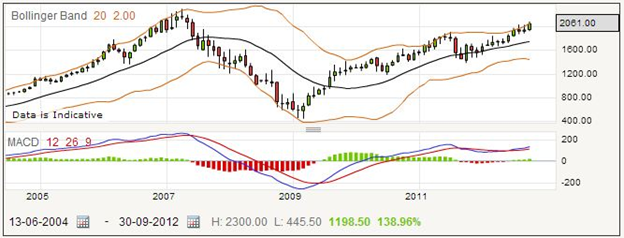Derwent London Fundamentals
Unless you live in London, it is possible that you have not heard of Derwent London, even though it is a leading property investment and development company. This is a category that has provided some good opportunities in the past for spread betting, because of the changes in property values. Derwent London is a large company, valued at over £2 billion, and specializes in London properties. It is registered as a REIT, a real estate investment trust, which gives the company and therefore investors in it preferential tax treatment.

This is a monthly price chart, showing the impact of the economic downturn in 2007 and 2008. From a high of around 2300, the price of shares in Derwent London went down to the 400s. As you can see, it has turned around in recent years, and from a long-term perspective seems to be growing strongly.
The company is about 100 years old, having been originally established in 1913. However, for many years it was the operator of a light railway which closed in 1981. In 1984 it started business again as a property company, and merged in 2007 with London Merchant Securities to become the current Derwent London.
In the same year it registered as a real estate investment trust, a tax category that only came into existence in 2007 in the UK, despite having been used for some years in the United States. To qualify for preferential treatment, REITs must distribute at least 90% of their earnings to the shareholders.
Inevitably, some of Derwent London’s development plans have been contentious, and some have been knocked down by the planners and / or public outcry. But as a major owner of London property, the company should be looking forward to the future. If you look at the shorter-term price charts, you will see a reasonable amount of volatility which can lead to good profits when spread trading.
Derwent London Rolling Daily: How to Spread Bet on Derwent London shares?
The property investment company Derwent London seems to be growing strongly. If you want to take out a long spread bet on the share price, the current quote is 2057 – 2070. You could choose to stake £1.50 per point.
If there is a favourable outcome to your bet, you may find that you are able to close the bet to lock in your winnings when the price is 2213 – 2226. Although your spread betting provider will advise you how much you have won, you should be able to work it out for yourself for your records. Your long bet was placed at the buying price of 2070. It closed at the selling price of 2213. That means you have gained 2213 minus 2070 points. This works out to 143 points. Multiply this by £1.50 to find that your winnings are £214.50. As this is a rolling daily bet, you may not find that your account increases by exactly this amount. Typically your spread betting provider will charge you a small amount each evening when the bet is rolled over.
If the spread bet does not work out in your favour, you must be sure to close your bet to curtail your losses. You might see the price drop down to 1986 – 1999 before you end the trade. This time your closing price was 1986, so taking that away from the opening price of 2070 you would find that you have lost 84 points. For your chosen size of stake, this would be £126.
One way to make sure that your bet, if losing, is closed quickly, is to use a stop loss order. This tells your broker to close the trade without referring back to you. A stop loss order in this case might have closed the bet at 2007 – 2020. This time the closing price is 2007, so the points difference is 63, which would cost you £94.50 on your current wager.
Derwent London Quarterly Futures Bet
The futures style spread bet is appropriate if you think the price will change over a few weeks or months. After a few weeks of a rolling daily bet, you will find that the rollover charges start to mount up, and there are no separate charges with a futures style bet. The current price for the far quarter on Derwent London is 2071 – 2086. Should you decide that the price will go up, you could place a buy bet at 2086, staking perhaps £2.50 per point.
Suppose for the sake of example that you are correct, and the price goes up to 2222 – 2236 in a few weeks. If you close the bet now, then you will have gained 2222 minus 2086 points, which is 136 points. As you chose to stake £2.50 per point, you have profited by £340.
However, you should not expect to win all of your spread trades, so as an alternative assume that the price goes down to 1978 – 1992. You may choose to close your bet and accept the loss, simply to avoid the price falling further. Your starting price was 2086, and the closing price was 1978. The difference between these is 108 points, which for this wager would cost you £270.
Many spread betters decide to use a stop loss order on every trade, merely so that they do not need to keep such a close eye on the market price, knowing that the bet will be closed for them if it drops to a certain level. In this case, you might find that a stoploss order would close your losing bet when it falls to 2003 – 2017. As before, your starting price was 2086, but this time the closing price was 2003. As this is a difference of 83 points, your loss would be £207.50.